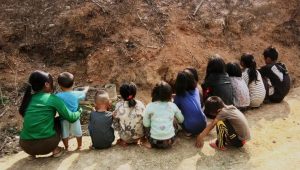The number of Myanmar nationals who have fled the country following the military coup and taken refuge in India’s Northeast could be more than the estimate arrived at by the United Nations.
A spokesperson of the U.N. Secretary General Antonio Guterres told reporters that an estimated 4,000 to 6,000 refugees from Myanmar have sought safety in India, even as he raised concern over the increasing levels of displacement of people in the country since the military coup in February.
Spokesperson Stephane Dujarric’s statement followed an assessment by the United Nations Refugee Agency (UNRA), which pegged the figure of internally displaced people in Myanmar at 60,700 including women and children.
The U.N. team in Myanmar has urged all countries in the region to offer refuge and protection to the people who have fled the country due to the coup and ensuing crackdown, and made an appeal for humanitarian workers to be granted access to them.
In India, the refugees have crossed over to the twin states of Mizoram and Manipur, which share borders with Myanmar. The Indian government was reluctant to host the refugees when the crisis erupted and both the states were reminded to discourage them from settling down in India.
Despite the directive, both the state governments have been offering assistance to the refugees. After a few weeks India also condemned the repression in Myanmar while urging maximum restraint and release of the detained leaders. The five-point consensus on Myanmar released by ASEAN which makes a case for an immediate end to violence in the country, has been welcomed as well.
So far, official data on the number of refugees from Myanmar in the border states of India has not yet been made public. Workers engaged with NGOs in both states that have offered assistance to the refugees and government officials believe that the total number of people who have sought refuge could be close to 7,000.
A police official in Mizoram who spoke to the media on the condition of anonymity revealed that more than 5,600 Myanmar nationals, including 18 lawmakers, had sneaked into the border state since the military junta toppled the democratically elected government. He added that more than 100 refugees had returned to Myanmar.
Referring to the data compiled by the Crime Investigation Department (CID) in Mizoram, he pointed out that the border district Champhai had the highest number of refugees at 3,170 and the rest were scattered over eight other districts and sheltered by NGOs and villages across the state.
In Manipur, which is contiguous to and located northeast of Mizoram, fewer refugees have crossed over from Myanmar in the last three months, most of whom are staying in the border town of Moreh. Some NGOs offering support to them have estimated their numbers at over a thousand, including women and children.
Among the refugees in Manipur were seven Myanmar nationals who were granted “safe passage” by the high court in the state to approach the United Nations High Commissioner for Refugees (UNHCR) in New Delhi for protection. According to media reports, three of the seven Myanmar nationals are journalists working with Mizzima News, while the rest are their family members.
While hearing the petition of the group, the court observed that though India had no clear refugee protection policy, it did grant asylum to a large number of refugees from the neighboring country. It pointed out that that India usually respects UNHCR’s recognition of the status of such asylum seekers, especially from Afghanistan and Myanmar.

































